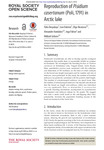Please use this identifier to cite or link to this item:
http://lib.hpu.edu.vn/handle/123456789/22274Full metadata record
| DC Field | Value | Language |
|---|---|---|
| dc.contributor.author | Bespalaya, Yulia | en_US |
| dc.contributor.author | Bolotov, Ivan | en_US |
| dc.contributor.author | Aksenova, Olga | en_US |
| dc.date.accessioned | 2016-07-18T06:49:08Z | |
| dc.date.available | 2016-07-18T06:49:08Z | |
| dc.date.issued | 2015 | en_US |
| dc.identifier.other | HPU4160431 | en_US |
| dc.identifier.uri | https://lib.hpu.edu.vn/handle/123456789/22274 | - |
| dc.description.abstract | Freshwater invertebrates are able to develop specific ecological adaptations that enable them to successfully inhabit an extreme environment. We investigated the brooding bivalve of Pisidium casertanum in Talatinskoe Lake, Vaigach Island, Arctic Russia. Here, quantitative surveys were conducted, with the collection and dissections of 765 molluscs, on the basis of which analyses on the brood sacs length (marsupia) and the number and size of embryos, were performed. | en_US |
| dc.format.extent | 13 p. | en_US |
| dc.format.mimetype | application/pdf | - |
| dc.language.iso | en | en_US |
| dc.subject | Biology | en_US |
| dc.subject | Ecology | en_US |
| dc.subject | Adaptive strategy | en_US |
| dc.subject | Arctic | en_US |
| dc.subject | Asynchronous brooding | en_US |
| dc.subject | Embryonic growth | en_US |
| dc.subject | Pisidiumspecies | en_US |
| dc.subject | Adaptive coin-flipping | en_US |
| dc.title | Reproduction of Pisidium casertanum in Arctic lake | en_US |
| dc.type | Article | en_US |
| dc.size | 1.04MB | en_US |
| dc.department | Education | en_US |
| Appears in Collections: | Education | |
Files in This Item:
| File | Description | Size | Format | |
|---|---|---|---|---|
| 0314_Reproduction.pdf Restricted Access | 1.07 MB | Adobe PDF |  View/Open Request a copy |
Items in DSpace are protected by copyright, with all rights reserved, unless otherwise indicated.
